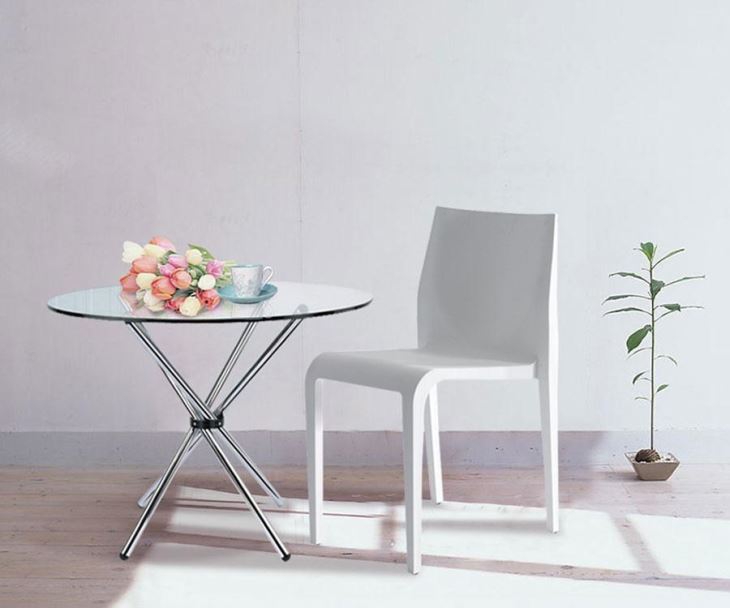- Apr 27, 2025-
As a sustainability blogger, I often explore the intersection of design and environmental responsibility. One area that has garnered significant attention lately is furniture made from plastic—a material that, despite its bad rap, can be part of a sustainable lifestyle when used responsibly. In this blog post, I'll delve into the world of plastic chairs, examining their benefits, drawbacks, and how they align with eco-conscious values.
Plastic chairs have become ubiquitous in homes, offices, hotels, and public spaces. Their versatility, durability, and affordability make them a popular choice for many people. However, the environmental impact of plastic is a major concern. Unlike natural materials like wood or metal, plastic doesn't biodegrade easily and can persist in the environment for centuries.
That said, not all plastic chairs are created equal. Many manufacturers now prioritize sustainability by using recycled materials, reducing waste, and designing products that last longer. These advancements make plastic chairs a viable option for those looking to balance comfort, style, and environmental responsibility.
When evaluating the sustainability of any product, it's essential to consider its entire lifecycle—from production to disposal. For plastic chairs, this means examining how the raw materials are sourced, how the product is manufactured, and what happens at the end of its useful life.
Material Sourcing: Many plastic chairs today are made from recycled materials, which significantly reduces the environmental impact compared to virgin plastics. Using recycled content lowers energy consumption and minimizes waste.

Manufacturing Process: Modern manufacturing techniques for plastic chairs often prioritize efficiency, reducing emissions and resource use. Some companies even offset their carbon footprint through renewable energy or carbon credits.
End-of-Life Options: Unlike traditional plastic products that end up in landfills, many plastic chairs can be recycled or repurposed. Look for models with modular designs that allow for easy disassembly and replacement of parts, extending the chair's lifespan.
Sustainability isn't just about environmental impact—it's also about creating products that meet user needs while minimizing waste.塑料椅子的设计必须在美观、舒适性和耐用性之间找到平衡,才能真正成为环保的选择。
Many modern plastic chairs feature clean lines and minimalist aesthetics, making them suitable for a variety of settings. Whether you're looking for outdoor seating for your backyard or lightweight chairs for your next event, there's a design out there that suits every lifestyle.
One standout example is the Plastic Chair-DC-42 (available at http://idochair.com/plastic-chairs/plastic-chair-dc-42.html), which combines durability with a sleek, modern look. Its lightweight construction makes it easy to move around, while its ergonomic design ensures comfort during long periods of sitting.
One of the key advantages of plastic chairs is their low maintenance requirements. Unlike wood furniture, which may require frequent refinishing or treatment, plastic chairs are resistant to moisture, stains, and pests. This makes them ideal for outdoor use or high-traffic areas.
To maximize the lifespan of your plastic chair, consider the following tips: - Cleaning: Regularly clean your chair with a mild soap and water solution to prevent dirt buildup. - Storage: If you're not using your chair during winter or other off-seasons, store it in a dry place to avoid exposure to harsh weather conditions. - Repair: Many plastic chairs are designed with modular parts that can be easily replaced if damaged. Look for models like the Plastic Chair-DC-19W (available at http://idochair.com/plastic-chairs/plastic-chair-dc-19w.html) that offer repair-friendly designs.
The furniture industry is undergoing a significant shift toward sustainability, and plastic chairs are no exception. New innovations are emerging to address the environmental challenges associated with traditional plastics.
One promising development is the use of bioplastics—materials derived from renewable resources such as cornstarch or sugarcane. These biodegradable alternatives break down more quickly in the environment, reducing their long-term impact. For instance, the Plastic Chair-DC-671 (available at http://idochair.com/plastic-chairs/plastic-chair-dc-671.html) is an excellent example of how bioplastics can be used to create durable, eco-friendly seating solutions.
Another trend is the rise of upcycled furniture—products made from reclaimed or repurposed materials. This approach not only reduces waste but also adds unique character to each piece. If you're looking for a one-of-a-kind chair with a story, consider exploring upcycled plastic designs.
Plastic chairs can be a sustainable option when chosen wisely. By selecting models made from recycled materials, designed for durability and ease of maintenance, and manufactured with the environment in mind, you can enjoy the benefits of modern design while minimizing your ecological footprint.

As we move forward, it's crucial to support companies that prioritize sustainability—those that use innovative materials, reduce waste, and promote responsible consumption. By making informed choices about our furniture, we can contribute to a healthier planet for future generations.
References: 1. Smith, J. (2021). The Sustainable Home: A Guide to Modern Living. Green Press. 2.塑料产业协会. (2023). Plastic Chairs and the Environment: Current Trends and Innovations. 3. 环境保护局. (2022). Reducing Waste in Household Furniture.